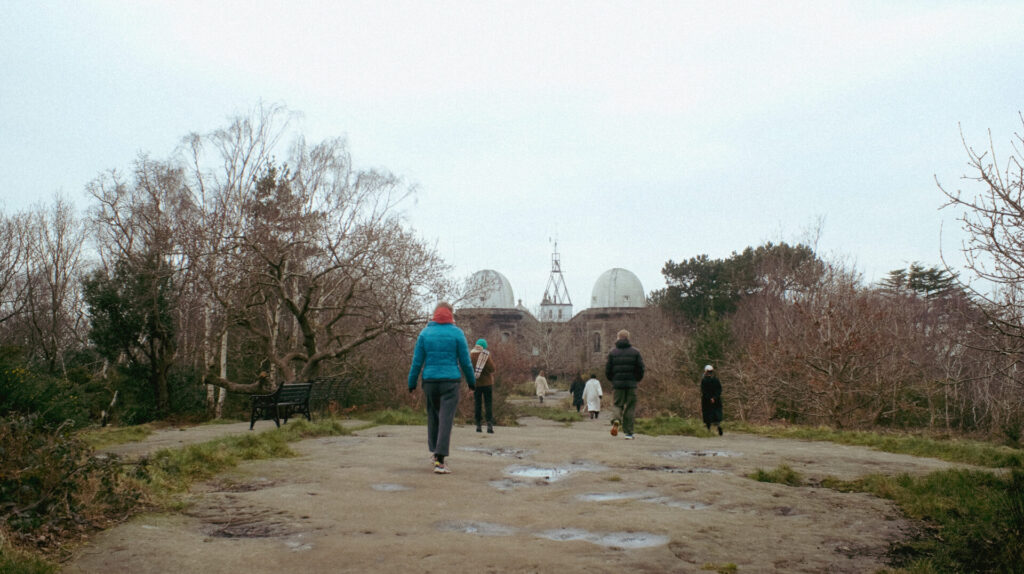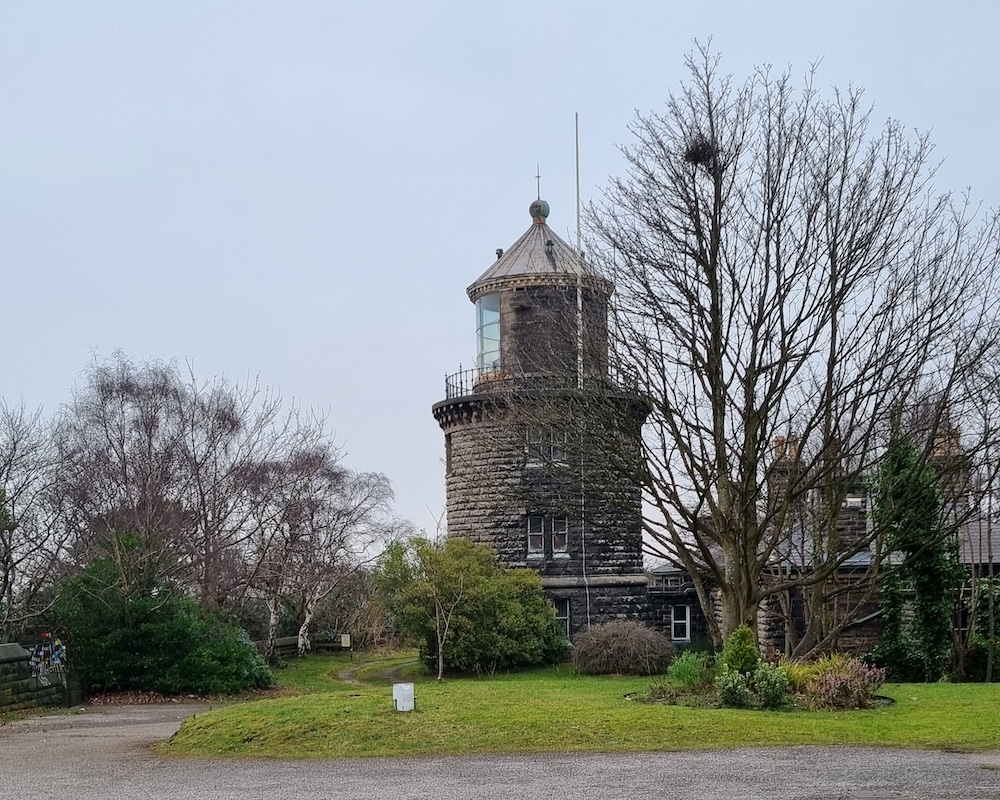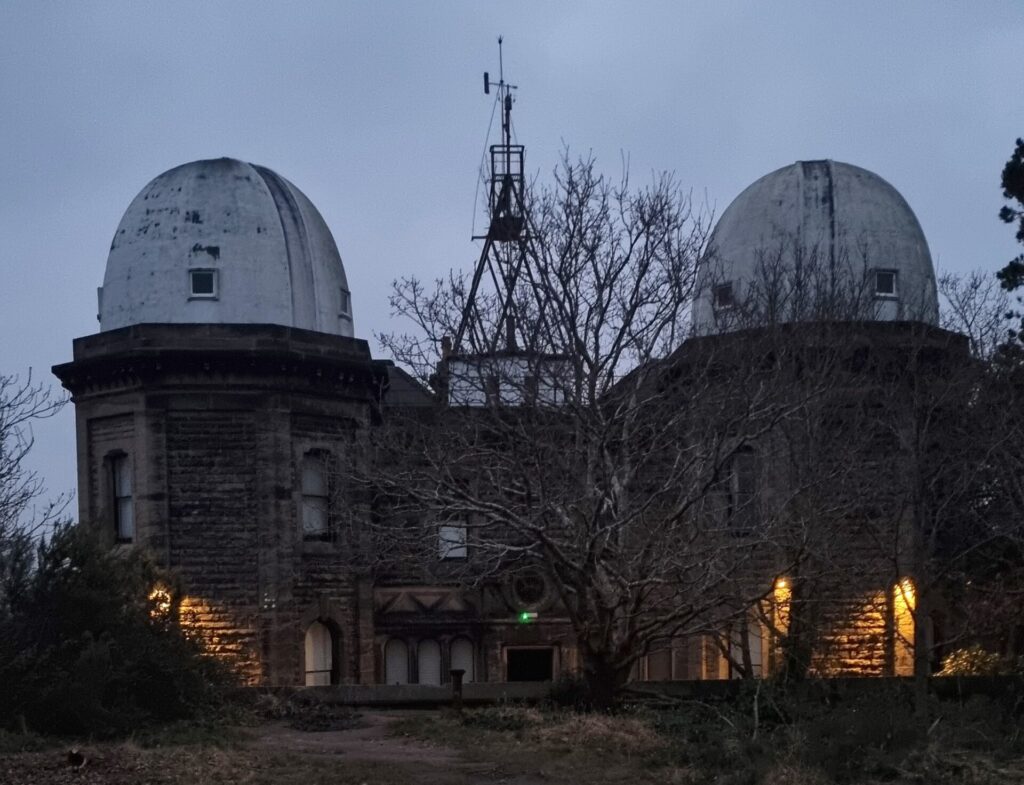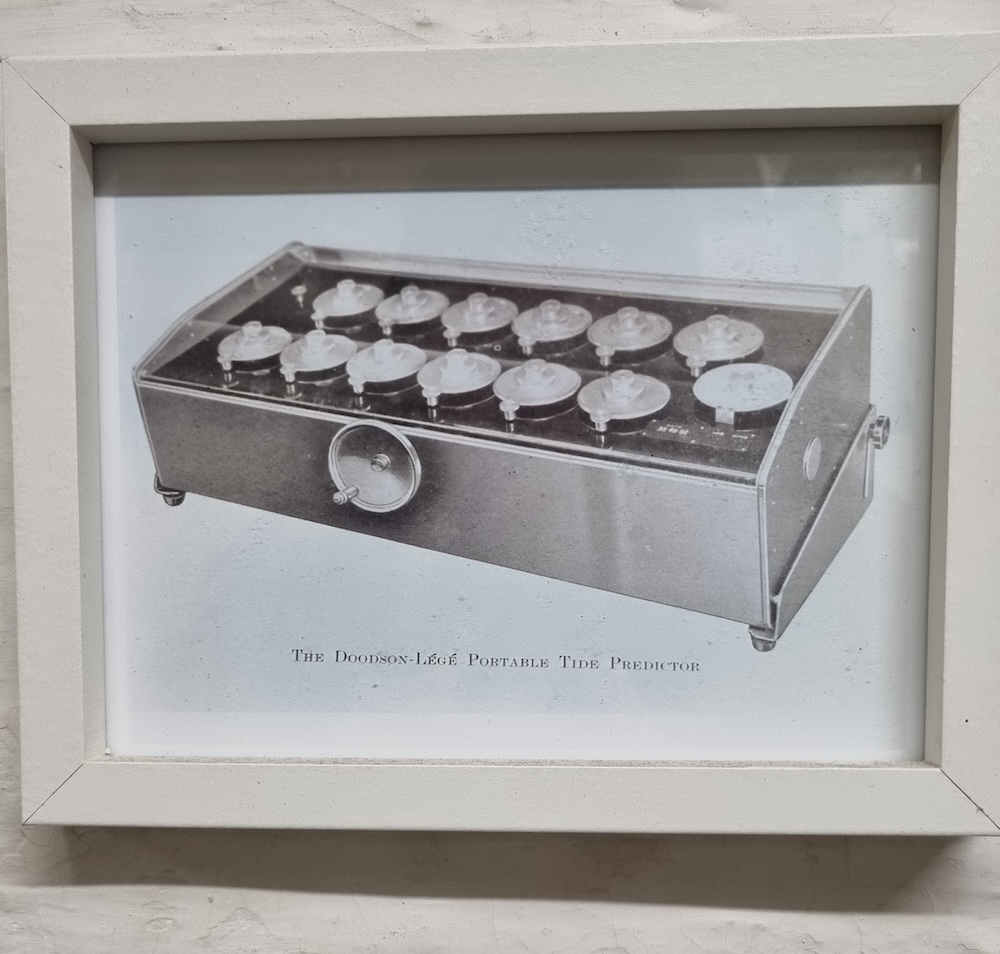Anton Spice spends a weekend at Birkenhead’s Bidston Observatory with drone choir collective NYX.

Photo: Ami Bevilacqua. All other photos: Anton Spice.
In 1864, under the instruction of the Mersey Docks and Harbour Board, engineers began excavating several tons of sandstone from the top of Bidston Hill in Birkenhead on The Wirral peninsula, digging away a cavity that would become the basement and sub-basements of a new observatory. Positioned between a lighthouse and a windmill on what remains 180 acres of public land, Bidston Observatory was built with the excavated stone and conceived as a scientific instrument in its own right, with an internal architecture designed to protect the delicate equipment from outside interference. The hill, it was said, had many secrets, and there are stories of ghosts that haunt the windmill, of UFO sightings and occult gatherings, pagan rituals and mysterious carvings. Over the following years, the observatory would reveal secrets of its own.
It is a grey Saturday morning in February 2025 and I have come to Bidston to spend a weekend with vocal collective NYX in preparation for the release of their debut album, whose synthesis of drone and electronic influences feels as though it is both recalling ancient spirits and ushering in new ones. The observatory is a forbidding structure in this light, its façade blackened by a century of industrial pollution rising up the hill from Birkenhead shipyard. As I wait to enter, I catch the uncanny strains of choral warm-ups reverberating through the thick stone walls.
The door opens and I am invited in by NYX creative director Phillipa Neels, who leads me straight into the front room where founder and musical director Sian O’Gorman is leading the group in a vocal round with a shruti box. I grab a yoga mat and join for breathing exercises guided by Imogen Knight, whose somatic workshops are an integral part of what binds this shape-shifting ensemble of women’s voices together. Eleven members have made the trip to Bidston for a rare meeting outside rehearsal, recording and performance commitments. Imogen’s daughter is here too, scuttling around at floor level and bouncing between the group before throwing herself into a pile of mattresses in the corner.

The circle dissolves and I am given a tour of the building, beginning at the top. The first of the observatory’s two domes is thick with cold, damp air. Its curved, wood-panelled ceiling swallows sound whole. In the second dome stands a lectern, behind which a hymn board is nailed to the wall. The air is even tighter here and I struggle to catch my breath, heading out onto the roof where the view opens out towards the Irish Sea. As the wind picks up, I think of the years when Bidston Hill was home to a 100-flag signalling system, guiding merchant vessels into the docks. It’s curious, I wonder, that there is also a lighthouse here, two miles from the water, only to later learn that when it was built in the late 18th century, the lamp was fitted with an innovative, thirteen-and-a-half foot parabolic reflector, burning a gallon of oil every four hours, to make sure it could be seen.
An article in the Liverpool Mercury published at the end of 1866 described Bidston as ‘one of the most complete observatories at present in existence’, in part because it too was designed with scientific specifications in mind. Each of the observatory’s two domes were positioned on top of hexagonal towers at the south-east and south-west ends of the building, housing an instrument whose purpose was to take the time, fix the latitude and determine the declination of the stars. Such was the accuracy required, that the building was encircled by an 18-inch trench that isolated it from unwanted disturbances caused by horse-drawn carriages coming up the hill. The dome was supported by a vast pillar, nine feet in diameter, which passed up from the bedrock, without ever coming into contact with the building. Vibration was mitigated at all costs. By the time I go back inside, NYX have hauled a PA speaker into one of the domes and are letting themselves go. It is barely lunchtime, and the building is pulsing with sub bass and Medusa spirit.
I take the spiral stairs down through the library, and keep going, beyond the kitchen and into the first and then the second of two basements. Here, I find another vocal circle forming, seated on cushions on the stone floor of a narrow subterranean chamber. The group is rolling through a rendition of ‘Dream Baby Dream’, a cover of the classic Suicide track that closes out their self-titled debut album. They fill the room with sound and receive its echoes as their own.

As well as astronomical work, the observatory made use of its relationship to the earth to take seismographic measurements. Behind where the group is now sitting is a gap chiselled from the brickwork that was once home to a horizontal pendulum so delicate it picked up the eruption of Krakatoa volcano in Indonesia in 1883. Nearby is a hole, core-drilled down through the sandstone hill to the water table sixty-six metres below. It may well be the deepest hole in The Wirral.
Proximity to the water and the merging of the observatory with the Tidal Institute in the early 20th century directed much of Bidston’s research towards nautical matters. Ship’s chronometers were of great interest, and many attempts were made to mitigate the minute misalignments that took place in hot equatorial climates. Everywhere are traces of the role the observatory played in the machinations of empire and colonialism, the creation of wealth from extraction and the pursuits of Western science in first knowing and then controlling the world.
Under the auspices of mathematician and oceanographer Arthur Thomas Doodson, Bidston also became known for the development of the Doodson-Légé Tide Prediction Machine, capable of predicting tidal patterns anywhere in the world for up to a year, most famously perhaps during the D-Day landings. To operate the machine, Doodson employed only women, because he believed they were less likely to make mistakes and that their handwriting was neater. In its own way this was a radical act in 1930s Britain, where women were rarely given professional responsibilities of a scientific nature. The Anglo-Norse Sun Goddess carved into Bidston Hill a thousand years earlier was deemed unusual for the same reason, in that, for once, this deity was not depicted as a man.

Many of the women who worked at Bidston continued to stay in touch with the observatory, which ceased to operate in 2004, even as they approached their own centenaries. In that time, they will have seen the de-industrialisation of the region leave behind its own tremors and cavities, into which creative pursuits such as the Bidston Observatory Artistic Research Centre (BOARC) now hosting us have grown. It’s a history that artists who visit are actively encouraged to grapple with.
We gather for dinner in the large dining area and light candles that flicker and dance and send shadows up the walls, before heading back down the basement, where a radio studio has been set up in a room next to a framed photo of a portable Doodson-Légé. There we listen to NYX’s album in full, letting the swells of sound wash over us, connected in spirit at least to the movement of the stars, the moon, the earth and the waves that have been channelled through the observatory over the last 150 years, and through Bidston Hill for many thousand more. A building hewn from the rock on which it sits, looking up to the sky and down to the core, where sensing is transformed into sense-making and the physical world meets our desire to know something about it.

The following morning we assemble one final time for a vocal session in the same room I had been welcomed into the previous day. This time I am humming along with the group and enjoy the sensation of the sound vibrating through my ribcage. What starts as a formless improvisation begins to take a shape, guided by the collective, led by no-one. There is something of the tide about it — the ebb and the flow — the magnetic forces that we intuit together as the sound rises into crescendos and then falls.
As a place of science, Bidston presents itself as an instrument, a term it shares with the act of making music. If the building is an instrument, then so is the body a building from which we sing, reverberant, undampened, designed to channel rather than reduce vibration. It too is finely calibrated, but under NYX’s spell, ultimately resists explanation.
*
Thank you to Ed Clive of BOARC, whose talk about the history of Bidston informed many of the details featured in this piece.
NYX’s self-titled debut album is out now.
Find Anton Spice’s previous work on Caught by the River here, and follow him on Instagram here.